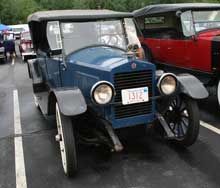Hudson's Companion
By 1916, the Hudson Motor Car Company had established itself, according to the advertising, as the "world's largest builder of six-cylinder cars." Not only had the company produced the massive 421 cubic inch Six-54, it had pioneered the counterbalanced crankshaft with the much smaller Super Six. Company president Roy Chapin there might also be a market for a less-expensive Hudson product, and so came Essex, first of the "companion makes," launched at the Los Angeles Auto Show in January 1919.
Designed by Swiss engineer Emile Huber, Hungarian Stephen Fekete, and Stuart Baits, the Essex was powered by a spirited little F-head four of 179 cubic inches. The same size as Henry Ford's Model T engine, it made nearly three times the power, and had such advanced features as automatic spark advance. Initially sold mostly as open models, Essex introduced one of the first low-priced closed cars, the two-door coach, in 1922. By 1924, the coach sold for less than a touring car, and the F-head four had given way to a smaller L-head six. Initially plagued with lubrication problems, the Essex six was iteratively improved and managed to advance Essex sales, which had from introduction surpassed those of parent Hudson, to achieve third place in the industry by 1929.
Essex introduced an all-steel coach body in 1926, so strong and men could hang out on its doors. In 1927 and 1929 there were boat-tailed Speedabout roadsters, and in 1930, when bodies were shared with Hudson, an attractive Sun Sedan. There was a boat-tailed Sport Roadster in 1931, when Essex mimicked Hudson's looks, but by 1932 it was becoming old hat and sales suffered. Hudson responded with a new model, the Essex Terraplane, smaller, lighter and cheaper than ever before. Hudson promoted "Land Flying," and engaged aviatrix Amelia Earhart to christen the car and presented one of the first to Orville Wright. Whereas Essex had sold opposite Pontiac and Dodge, at $425 to $610 Terraplane was a Ford-Chevrolet competitor. An eight-cylinder Terraplane for 1933 gave Ford a run for its money on the road, if not in sales, and Terraplanes competed in races and hill climbs.
Terraplane never did equal the 1929 sales rank of Essex, best showing of an independent marque until Rambler displaced Plymouth in 1961, but it did save the Hudson Motor Car Company as the Depression deepened. The first of the companions, Essex gave up its name in favor of Terrplane by the time 1934 rolled around. It had, however, paved the way for nearly a dozen similar marques from other manufacturers, and if you consider Terraplane as lineal descendant of Essex it was surely one of the longest-lived and most successful.

